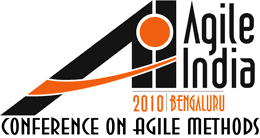 |
 |
|
|
Using Theory of Constraint and Just-In-Time Practice to coach Agile TeamsIntentTo share our experience coaching agile teams. We'd like to present:1. How to apply Theory of Constraint [ToC] to identify the bottlenecks or issues the teams are facing during their agile adoption? 2. Once we identify the bottleneck, how we delivered knowledge and experience to the teams, just in time to apply that knowledge to eliminate the bottleneck, using the Just-In-Time practice concept? Intended AudienceThis paper is targeted at agile coaches and practitioners who help other teams adopt agile. Since this paper will present an approach to adopt agile practices, it can be helpful to teams who are in the process of or are planning to transition to agile.Format90 mins talkSummaryContextOver the last several years, We've helped enterprise architecture and application teams at various organizations to adopt agile practices. The management was sold that agile would help them improve their development process. We were assigned the task of making the teams more productive by using agile methods. ForcesThe big question was, where do we start? We could take the XP white book and slap all the 12 practices on them. But we knew that would certainly not work. Also, we did not know what were the real issues from the team's point of view? Different stakeholders had different things they wanted to improve. It was not clear what the real issue were? So the question is where do we start? ApproachWell, conducting a team retrospective felt like a decent option. So we started with a retrospective. During this we got an initial list of issues [which are really user stories for a coach] that the team wanted to resolve. At the end of the retrospective, we had our master story list or product backlog [list of issues faced by the team, which we would help them to resolve]. We took this list and asked our customers [the team] to prioritize the issues. They were asked to prioritize, based on what hurt them the most and fixing which issue, will deliver max relief to the team. SolutionSoon we found ourself applying ToC to find out process/people bottleneck in the system. Subsequently, we discussed this with the team to see what they think can fix the problem. We're consciously trying not to overload them with practices. We wanted the team to own those practices. We would help them figure out what works and what does not, what effect the practice has on the team dynamics, etc. We was trying to deliver the knowledge and experience to the teams, just in time for them to apply that knowledge. Once we figure out the problem at hand; the technique of picking up a practice that can address the problem in the simplest possible way is known as "Just-In-Time practice". One has to carefully craft out the version of the practice that would give them the fastest feedback. In other words, set up the practice so that if it fails, it fails fast. ConclusionWe've successfully applied TOC to identify the issue teams face during their agile adoption phase. Using the Just-In-Time practice helped me facilitate this transition better. Speakers J. B. Rainsberger & Naresh Jain |
|
||||||||||||||||||||||||||||||||||||||||||||||||||||||||||||||||||||
| 2005-2019 Copyright © Agile Software Community of India |
| Website designed and hosted by Xnsio |






